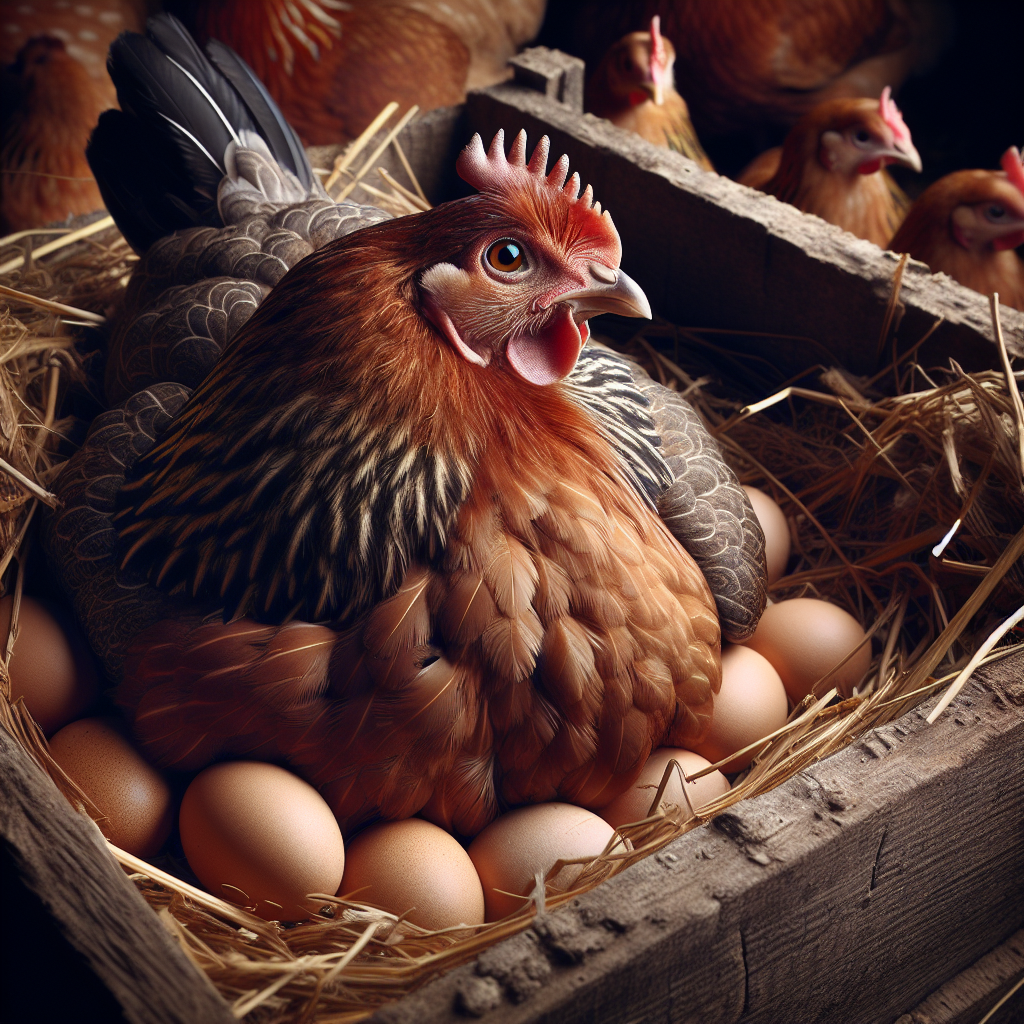Are you facing the challenge of managing broody hens within a larger flock? It can be a tricky situation, but with the right strategies, you can successfully navigate through it. When broody hens become determined to sit on eggs and hatch chicks, it can disrupt the dynamics of your flock. In this article, we will explore some practical tips and techniques that will help you effectively manage broody hens within a larger flock, ensuring harmony and productivity for all.
Identifying broody hens
Physical signs of broodiness
Identifying broody hens within a larger flock can be quite essential in order to manage them effectively. One of the first indicators of broodiness is observing the physical signs that these hens exhibit. Broody hens often appear puffed up and hunkered down in the nesting boxes for extended periods of time. They may also pluck feathers from their breast area in order to create an area of direct contact with the eggs. Additionally, broody hens tend to have a distinctive “glazed” look in their eyes, as they become highly focused on the task of incubating their eggs.
Behavioral signs of broodiness
Apart from the physical signs, there are certain behavioral cues that can help you identify broody hens. These hens become highly protective of their nesting area, often hissing, growling, or pecking at others who approach. They may also stop roosting with the rest of the flock and instead choose to stay in the nesting box overnight. Furthermore, broody hens may exhibit a decrease in their appetite and overall activity level as they divert most of their energy towards incubation.
Effects of broodiness on the flock
Decreased egg production
Broodiness in hens can have a significant impact on egg production within the flock. As broody hens focus their efforts on incubating eggs, they often stop laying new ones. This can lead to a noticeable decrease in the overall egg production of the flock. If left unmanaged, broodiness in multiple hens simultaneously can result in a considerable reduction in egg availability, which may not be desirable for those relying on a steady supply of fresh eggs.
Disturbance of flock dynamics
Another consequence of broodiness is the disruption it can cause to the social dynamics of the flock. Broody hens become highly territorial and may exhibit aggressive behavior towards other flock members trying to approach their nesting area. This can create tension and result in increased pecking or even injury among the hens. It is important to manage broodiness promptly to maintain a harmonious flock environment and prevent any potential harm to the hens.
Increased risk of disease transmission
When broody hens spend prolonged periods of time in the nest box, they can easily become susceptible to certain health issues. Moisture and warmth provide ideal conditions for the growth of harmful bacteria, increasing the risk of diseases spreading within the flock. Additionally, the lack of cleanliness in the nesting area due to broody hens’ prolonged presence can contribute to unsanitary conditions, further exacerbating the threat of disease transmission. Proper management of broody hens can help mitigate these risks and maintain the overall health of the flock.
Creating a separate space
Importance of a broody box
Creating a separate space, commonly referred to as a “broody box,” is crucial for managing broody hens effectively. A broody box provides hens a dedicated area where they can satisfy their instinctual urge to incubate eggs without disrupting the rest of the flock. It not only allows the broody hen to have her own space but also reduces the risk of aggression or injury among flock members. The broody box provides a controlled environment where the hen can fulfill her nesting instincts without interfering with the overall dynamics of the flock.
Setting up a separate area for broody hens
To set up a broody box, you can use a large dog crate or a sectioned-off space within the coop or run. It should be a well-ventilated area that allows the broody hen to have some privacy. Ensure that the broody box is easily accessible and has a secure door or mesh panel to prevent other hens from entering. Providing the broody hen with her own food and water within this separate space is also recommended to minimize disruptions when she needs to leave the box briefly.
Providing suitable nesting materials
Types of nesting materials
To encourage a broody hen to stay in the designated broody box, it is essential to provide suitable nesting materials. These materials should mimic the natural environment where a hen would lay her eggs and incubate them. Popular choices for nesting materials include straw, wood shavings, and hay. These materials should be easily accessible, clean, and soft, providing comfort to the broody hen during her extended time in the nest box.
Importance of clean and comfortable nest boxes
In addition to appropriate nesting materials, ensuring clean and comfortable nest boxes is crucial. Dirty or cramped nest boxes can discourage broody hens from utilizing them. Regularly cleaning and maintaining the nest boxes not only keeps them hygienic and inviting for egg-laying hens but also provides a suitable environment for broody hens. A clean and comfortable nest box helps promote healthier nesting behavior and reduces the chances of disease transmission within the flock.
Managing broodiness through environmental changes
Adjusting lighting conditions
Managing broodiness can be achieved through simple environmental changes, starting with adjusting the lighting conditions. Broody hens are more likely to develop the urge to incubate eggs in darker areas. By increasing the overall light exposure in the coop or run, you can help discourage broodiness. Consider adding additional lighting fixtures to brighten up the area, ensuring that it reaches all corners of the coop. Providing a well-lit environment can help disrupt the broody hens’ natural instincts and bring them back to regular flock behavior.
Modifying temperature and ventilation
Temperature and ventilation play a significant role in managing broodiness within a flock. Broody hens often seek warmth and solitude to stimulate brooding behavior. By manipulating the temperature and ventilation in the coop, you can help discourage this behavior. Increasing air circulation and ensuring a cooler environment can help reduce the hens’ desire to spend extended periods incubating eggs. However, it is important to strike a balance and avoid extreme temperature changes that could adversely affect the health of the flock.
Egg management
Collecting eggs frequently
To discourage broody behavior, it is crucial to collect eggs more frequently from the nesting boxes. Leaving eggs in the box for prolonged periods can trigger a hen’s natural instinct to incubate them. By removing the eggs promptly, you minimize the opportunities for hens to become broody. Frequent egg collection also helps maintain egg freshness and prevents potential health risks associated with cracked or spoiled eggs.
Using artificial eggs to discourage broodiness
Introducing artificial eggs, such as ceramic or wooden eggs, can be an effective technique to discourage broodiness among hens. These eggs closely resemble real eggs and can trick broody hens into thinking their nests are already occupied. By placing artificial eggs in the nesting boxes, you can help deter hens from going broody by fulfilling their desire to brood on “eggs.”
Offering distractions and alternatives
Providing a dust bath
Offering distractions and alternatives can help redirect the broody hen’s attention from incubating eggs. Providing a designated area for dust baths, filled with sand or fine soil, can be highly beneficial. Broody hens enjoy dust bathing, and engaging in this natural behavior can help alleviate their broodiness. Additionally, dust bathing serves as a means to keep their feathers clean and free from potential parasites, further promoting their overall well-being.
Offering treats and enrichment
Introducing treats and enrichment activities can also help manage broodiness among hens. These activities not only provide mental stimulation but also encourage hens to engage in more active behavior rather than focusing solely on incubation. Distributing treats such as mealworms or scratch grains throughout the coop or run engages the hens in foraging behavior, keeping them occupied and potentially diverting their broody tendencies.
Introducing new flock members
Introducing new flock members can help disrupt the broody hen’s routine and offer alternative social interactions within the flock. The introduction of new hens or even juvenile chicks provides an opportunity for the broody hen to play a nurturing role without actually incubating eggs. This can help reduce her broody behaviors and reintegrate her into the flock dynamics. However, it is important to monitor the interactions between the broody hen and the new flock members to ensure safety and prevent aggression.
Break methods for broody hens
Cooling the broody hen
One method to break a hen’s broody behavior is by cooling her down. This can be done by placing the broody hen in a cool or cold environment. Some owners use items such as frozen water bottles or ice packs to cool down the nesting area. Alternatively, you can gently spray a broody hen with cool water, taking care not to soak her feathers completely. The sudden change in temperature can disrupt the hormonal changes associated with broodiness and discourage the hen from remaining in the nesting box.
Using confinement as a break method
Confinement is another effective method to break broody behavior in hens. By placing the broody hen in a wire-bottomed cage, you eliminate the comfortable environment that fosters broodiness. The wire mesh allows air to circulate beneath the hen, preventing her from nesting or incubating eggs. This break from prolonged nest box exposure can help reset the hen’s hormonal patterns and discourage her broodiness.
Natural remedies and techniques
Using cold water or ice
Cold water or ice can be used as a natural remedy to discourage broodiness in hens. By gently spraying or dipping the hen’s underside in cool water, you can help cool down her body temperature and reduce hormonal triggers associated with broodiness. It is important to remember that this method should be done with care and on a temporary basis to avoid stressing the hen or causing any health complications.
Placing broody hens in a wire-bottomed cage
Another natural technique involves placing the broody hen in a wire-bottomed cage within the coop or run. This method prevents the hen from fully relaxing in a comfortable nesting area. The wire mesh allows air circulation and cools the hen’s underbelly, discouraging her from incubating eggs. This method can be particularly effective when combined with environmental changes, such as increased lighting and ventilation.
Conclusion
Managing broody hens within a larger flock requires careful attention and implementation of various techniques. By identifying the physical and behavioral signs of broodiness, providing suitable nesting materials and a separate broody box, and making necessary environmental changes, broodiness can be effectively managed. Additionally, practicing methods such as frequent egg collection, offering distractions and alternatives, and utilizing break methods can help discourage broody behavior. It is important to strike a balance between respecting a hen’s natural instincts and maintaining a healthy flock dynamic. By implementing these strategies, you can successfully manage broody hens and ensure the overall well-being and productivity of your flock.




